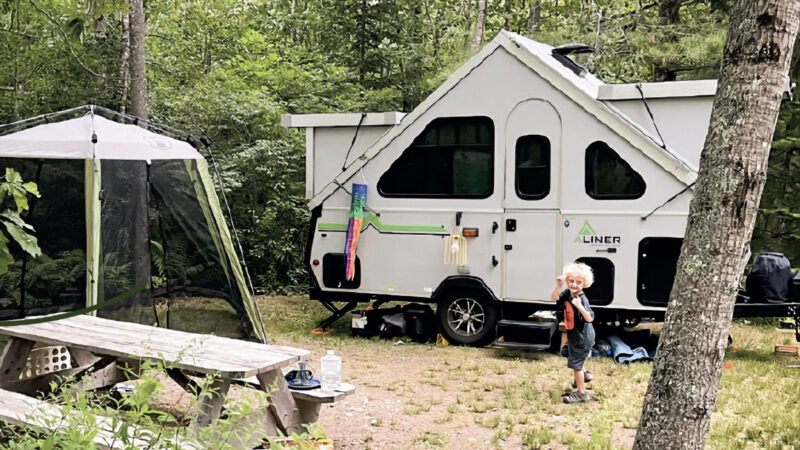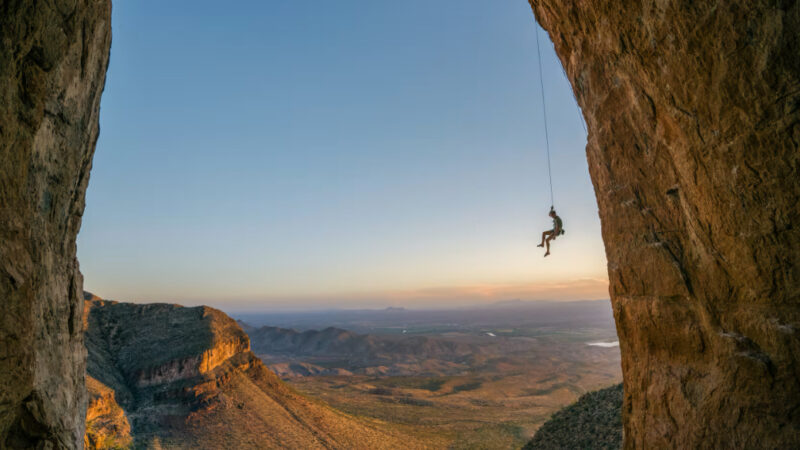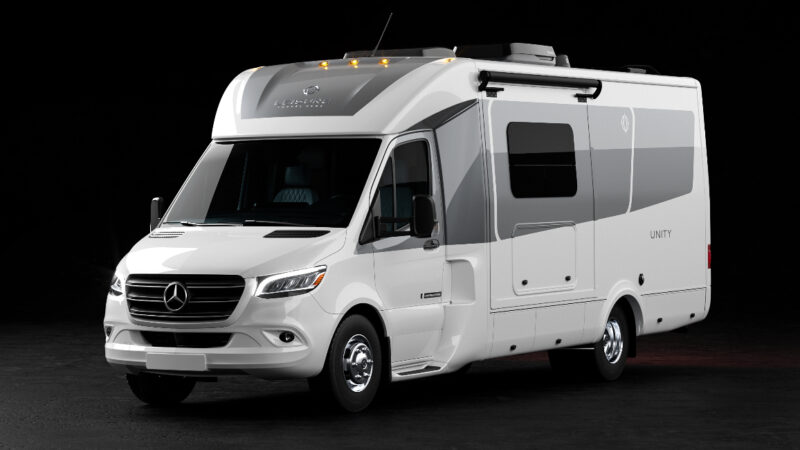How to Plan an RV Trip Using AI
It is safe to say that the biggest buzzword in tech this year is “artificial intelligence.” With its ability to understand plain language and compile compelling responses to just about any question, AI has sparked the imagination of millions of users while simultaneously raising ethical concerns about its use. However, this emerging new technology has proven to be very useful in a variety of tasks, including writing emails, comparing consumer goods, or researching complex topics. It can even write computer code to program an app and help you learn a new language.
One of the most useful ways to use AI is in trip planning. Artificial intelligence can help users find and book flights, get reviews of hotels, and provide insights on the best time to visit a destination. If you want, you can even have one of the programs create a complete itinerary for you, offering suggestions on where to go, what to eat, and what to do for your entire vacation.
But can AI help plan an RV trip? We tested the two most popular artificial intelligence apps currently available (ChatGPT and Google Bard) to see what they had to offer. As it turns out, both provided similar levels of assistance, each having own strengths and weaknesses. Here’s what we learned.

Photo Credit: Poca Wander Stock/Getty
What is Artificial Intelligence?
Before we take a look at what ChatGPT and Google Bard bring to the table for RVers, it is important that we have a basic understanding of what artificial intelligence is. In its most basic form, AI is a branch of computer science that creates software applications designed to simulate human intelligence and thought processes. It does this by creating an interface—often in the form of a “chatbot”—that users can interact with. Chatbots allow us to type questions or give instructions that generate appropriate responses in clear, concise, and well-organized ways, often taking the drudgery out of researching certain topics ourselves.
AI chatbots use large language models (LLMs) that are capable of recognizing complex sentences, identifying the essential elements of those phrases, and creating responses based on the knowledge they have access to. Usually, that knowledge comes in the form of a very large dataset that the AI has been trained on for generating responses. For ChatGPT and Bard, that dataset consists of gigantic chunks of the internet, giving them access to massive amounts of information that are used to quickly answer user queries.
In other words, when you ask an AI chatbot if it can help you plan an RV road trip, it knows that you want to travel and use a recreational vehicle as your means of transportation. In theory, it can craft a response that meets those needs. How well it responds depends on the information that it has at its disposal and the questions being asked of it.

Photo Credit: Anass Bachar/Getty
Why is AI Controversial?
AI chatbots are designed to acquire and analyze lots of information, learn from that data, and use it to provide answers to questions asked by its human users. The software is programmed to use rudimentary reasoning to achieve its goals. It also is designed to learn from user feedback to help fine-tune its algorithms to provide more accurate and reliable responses in the future. In this way, artificial intelligence is meant to get smarter over time.
But AI programmers have also added a measure of creativity to the software, allowing it to use machine learning and statistical analysis to generate entirely new responses to user input. That can come in the form of short and long-form text, art, music, and more. This has caused controversy among creative communities, which see AI as taking over some of the roles previously reserved for humans, including writers, artists, photographers, and musicians.
The other controversy surrounding the use of AI is that chatbots occasionally make up answers, providing users with faulty information. Programmers go to great lengths to try to prevent this from happening, but from time to time, users will receive answers that are flat-out wrong or include information that is entirely made up. Because of this, any AI-generated content should be manually verified for accuracy.

Image Courtesy of cookelma/Getty
Planning an RV Trip Using AI
With that cursory understanding of AI in mind, we set out to see how useful an AI chatbot could be in helping plan an RV road trip. To do that, we connected with ChatGPT through Microsoft’s Bing search engine and Bard from Google. Both chatbots use similar underlying technologies but have been trained on different datasets and programmed to respond in unique ways. The results were very intriguing, with some very positive responses.
It should be noted that there is an AI platform designed specifically with RVers in mind. It’s called AdventureGenie, and it promises to deliver smart trip planning that sorts through a database of over 25,000 campgrounds. This service can reportedly generate excellent RV travel itineraries, but a paid subscription is required to access its AI-powered trip planner. For the purpose of this article, we stuck to the free options that are currently available.
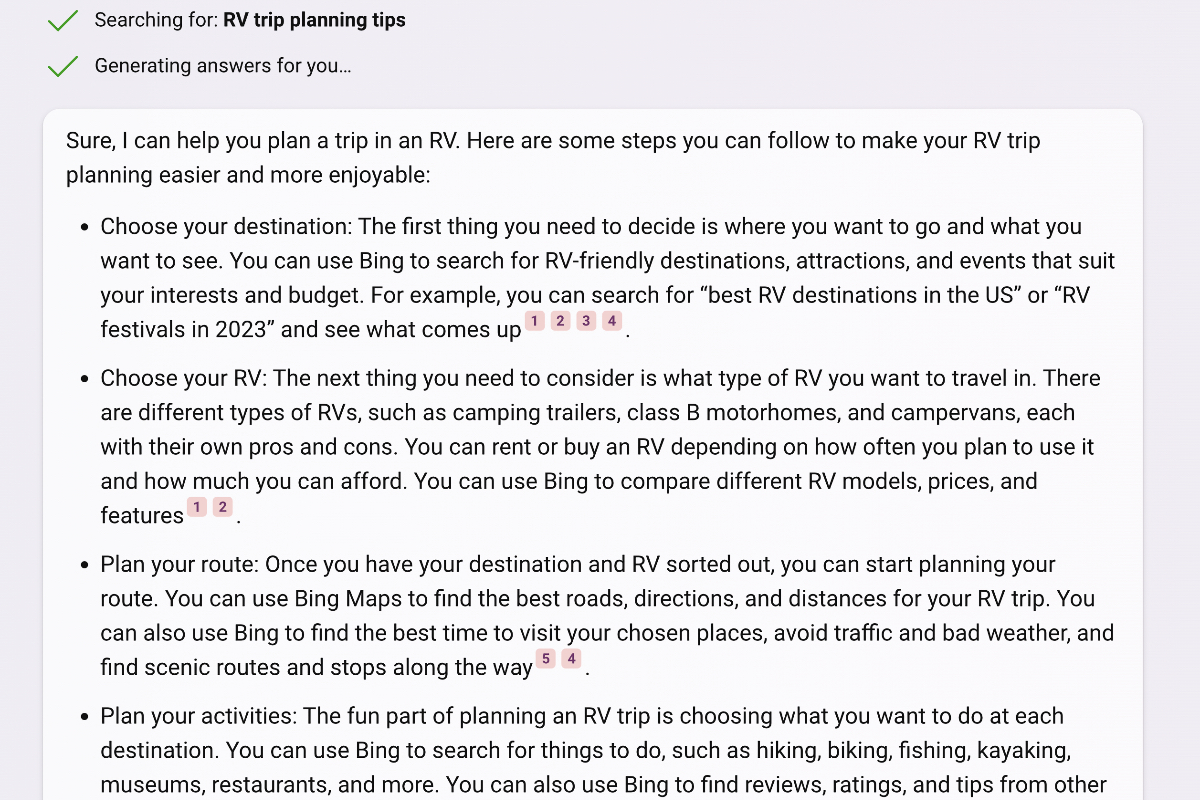
Photo Credit: Kraig Becker
RV Trip Planning with Microsoft Bing and ChatGPT
Microsoft was one of the first major tech companies to bring artificial intelligence to the masses, connecting its Bing search engine to ChatGPT. This chatbot is the creation of a startup called OpenAI and has been trained on a gigantic dataset culled from the internet. Its large-language model allows it to understand a broad range of queries and has made it incredibly useful, even for people who aren’t especially tech-oriented.
We first asked Bing if it could help us plan an RV road trip, which is a very generic question. It quickly told us it could assist with that process and provided some fundamental suggestions on how to get started. Those included selecting a specific destination, choosing the type of RV we wanted to drive, and considering the route we wanted to take on our journey. It also recommended planning the activities we wanted to do during our road trip and the type of campground we wanted to stay in. It even offered boondocking as an alternative to camping in a traditional campsite.
All in all, this was a good start, but the chatbot hadn’t really provided anything that an experienced RVer wouldn’t already know. So, we followed up our original query by asking Bing to assist in planning a classic road trip with visits to Yellowstone and Glacier National Parks in a Class B camper van. This provided much more interesting—and specific—results that included suggested places to visit, like Old Faithful, Mammoth Hot Springs, and the Going-to-the-Sun Road. Bing even recommended several campgrounds nearby that could accommodate a camper van.
Other details included suggested routes to take when traveling between the two parks, with a few places to stop while en route. Bing noted that it was a particularly scenic drive and estimated it would take about seven hours to complete. It even offered options for extending the trip into Canada, recommending visits to Waterton Lakes National Park and Banff National Park for those looking to add an international leg to their journey.
Bing’s results provided links to helpful websites, such as the National Park Service pages for campgrounds inside Yellowstone and Glacier. It also linked to useful maps and searches for other campsites in the area, connecting us to the online resources that it used to compile the information. This was how the chatbot cited its findings, allowing users to confirm the recommendations from other outlets and easily obtain more valuable tips and hints if needed.
Finally, we followed up with one last question, asking Bing to provide suggestions on where to hike in each national park. The chatbot dutifully offered multiple options and included trail names, the length of the hike, and a brief description of what to expect along the route. It organized its findings under separate headings for Yellowstone and Glacier, with seven options to choose from at each location.
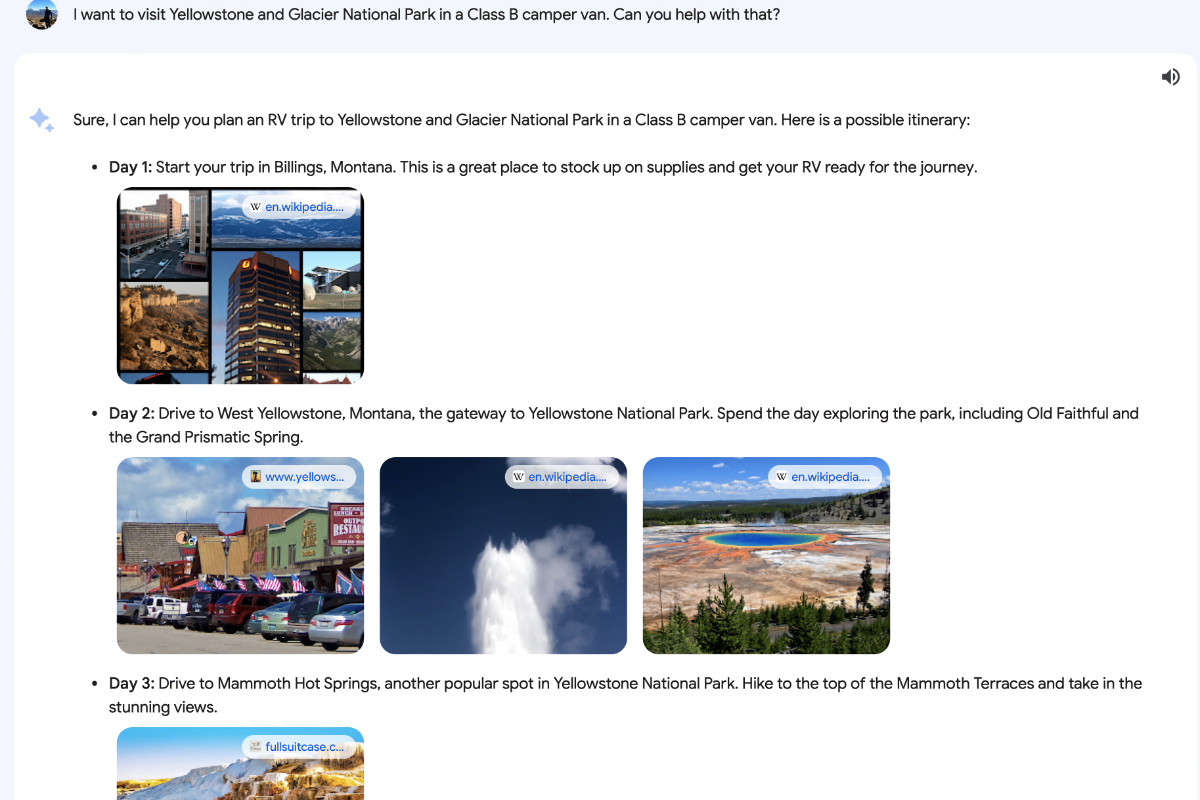
Photo Credit: Kraig Becker
RV Trip Planning with Google Bard
Bard is Google’s homegrown chatbot that provides many of the same features and functionality as ChatGPT. When it was first released, the AI seemed to lag behind Microsoft’s offering, but it has closed the gap considerably in the months that followed. Now, the two software projects seem to be on relatively equal footing, each with its own strengths and weaknesses.
As with ChatGPT, we began by asking Bard if it could help us plan an RV trip. The chatbot quickly indicated it could by providing a checklist of things to consider before setting off on such a trip. Those suggestions were similar to what Microsoft’s AI recommended, including selecting a specific destination, choosing an RV, and planning the route. But Bard went a little deeper by also advising us to set a budget, book our campsites early, and familiarize ourselves with our vehicle before setting out. It even told us to be flexible with our travel plans, as camping trips often don’t go as expected.
Next, we asked Bard to help us plan a road trip through Yellowstone and Glacier using a Class B camper van. This time, the results were very different than the ones we received from ChatGPT. Whereas Microsoft’s chatbot gave us a relatively rough outline of the trip, Google’s AI wrote a day-by-day itinerary for our vacation. The eight-day travel plan started and ended in Billings, Montana, with stops in various other towns along the way. Each entry offered suggestions on what to do that day, with photos providing visual cues of what to expect along the route. Clicking on those images took us to websites that provided more in-depth information and sometimes connected us with places to stay or travel companies offering organized tours and activities.
Bard wrapped up its daily itinerary by reminding RVers to book their campsites well in advance and to purchase a park pass prior to arriving in the national parks. It also recommended doing further research on what to do in Yellowstone and Glacier and wisely told us to be prepared for anything, most notably the quickly changing weather found in the region.
We really appreciated Bard’s ability to create a daily itinerary, which takes much of the research and guesswork out of the trip planning. But unlike ChatGPT, the AI didn’t recommend specific campgrounds to stay at, and its links to other websites were somewhat limited. The two chatbots also differed on how to spend our time on the trip. Bard scheduled three days in Yellowstone but just one full day in Glacier. Conversely, our Bing search recommended a minimum of five days in Yellowstone and four additional days in Glacier.
Finally, we also asked Bard to recommend some hiking trails in the two national parks. It responded with a list of five highly-rated routes that were accompanied by photos and a brief description. The list was adequate but didn’t offer the same depth as the one provided by ChatGPT. A couple of the suggestions were also relatively short and wouldn’t necessarily even be considered a proper hike by active outdoor enthusiasts. With this search query, Microsoft’s AI definitely provides a more impressive response.

Photo Credit: edb3_16/Getty
Should You Use an AI to Plan Your Next RV Trip?
After putting ChatGPT and Bard through their paces, it’s clear that both can be valuable tools for planning a trip. The two chatbots offered sound suggestions for things to do, places to go, and the best routes to reach the destinations. Both also provided links to external sources, allowing users to gather more helpful information. But Microsoft’s AI-powered search gave us more of those links, which ultimately proved more useful, particularly when verifying suggested activities and destinations.
We really liked Bard’s ability to create a whole itinerary from scratch, and its use of photos provided excellent context of what to expect while traveling. On the other hand, ChatGPT was better at suggesting places to park our rig, and its list of trails was more extensive, too.
So, are these tools worth using when planning an extended RV trip? Absolutely, although we do suggest double-checking the suggestions to confirm everything is accurate. That isn’t necessarily a slam against either of these AI chatbots, as travel information can often change quite suddenly. By reviewing the suggestions, you can avoid unexpected surprises and have a better understanding of the suggested itinerary as a whole.
In the future, these chatbots will become more intelligent and more accurate. They’ll also learn more about us, allowing them to provide more detailed suggestions for individual users. That will make them even more helpful for planning a trip of any kind. For now, though, think of them as travel advisors in their first few weeks on the job. They’re still learning and adapting and may occasionally make a mistake. But overall, they are eager to assist and are generally good at what they do.
You can take ChatGPT for a test drive using Microsoft’s Bing. Or, if you would prefer to give Bard a whirl, you’ll find it connected to Google’s powerful search engine. Spending a few minutes with one or the other will quickly provide an indication of what they can do and why so many technologists are so excited about the future of AI.
The post How to Plan an RV Trip Using AI appeared first on RV.com.
Source: https://www.rv.com/lifestyle-travel/places-to-go-things-to-do/how-to-plan-an-rv-trip-using-ai/



